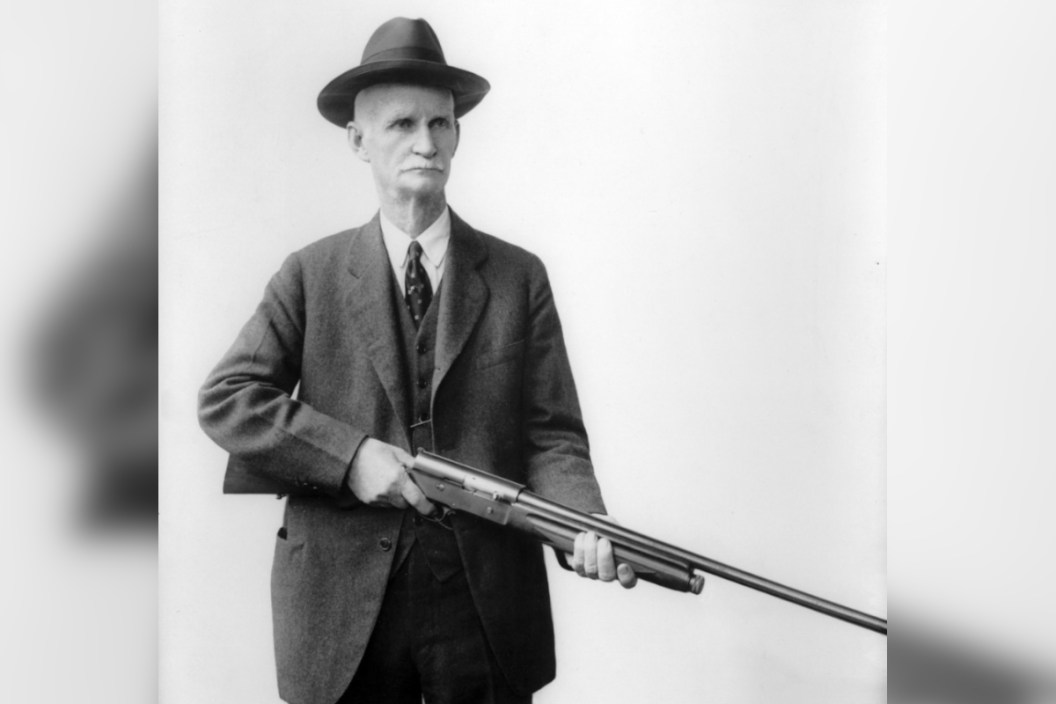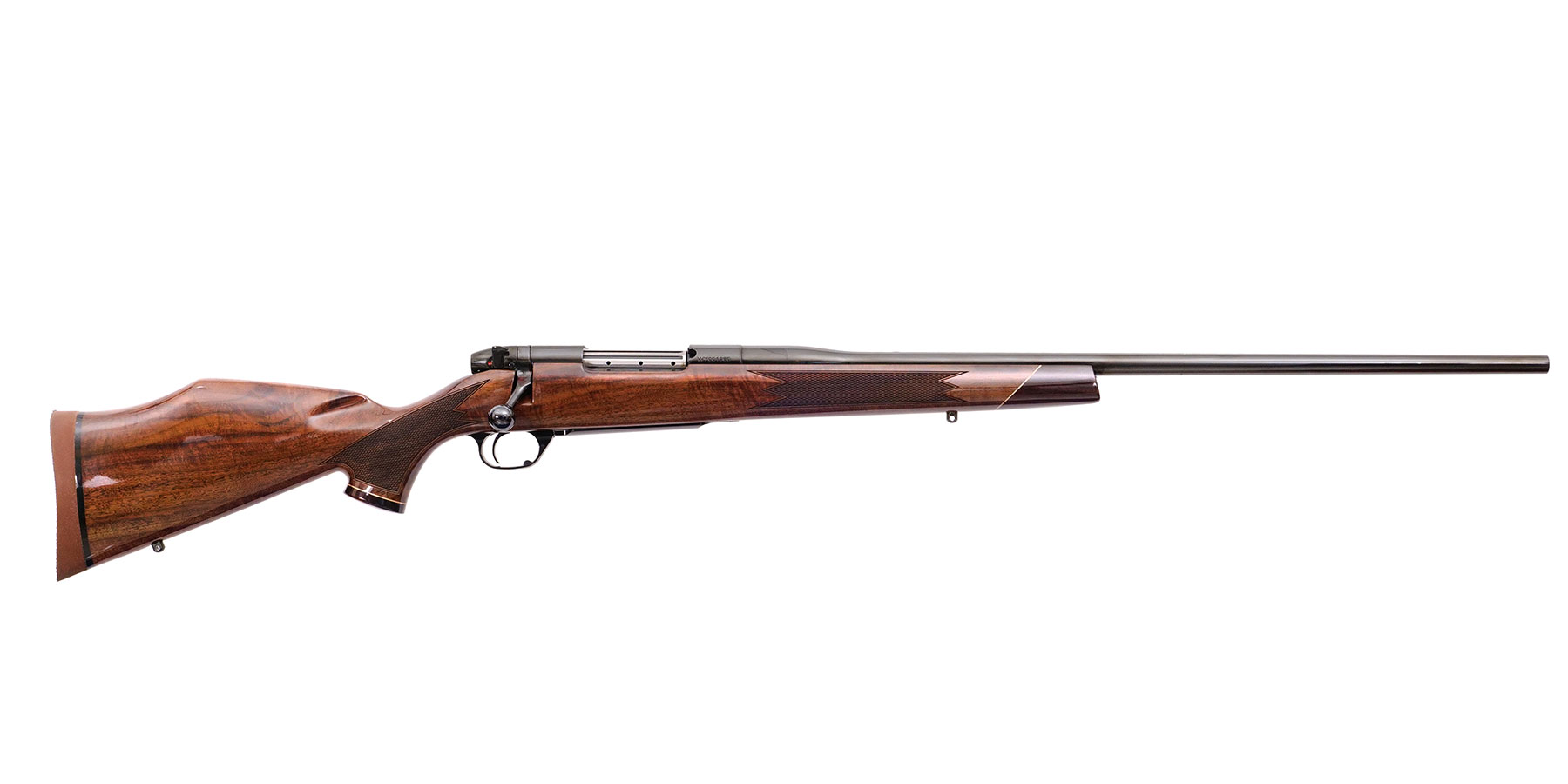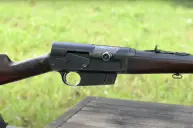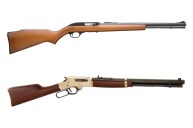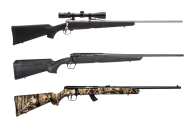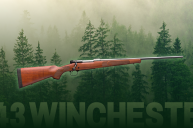These are the guns that changed everything.
North America has a long and storied history of hunting. It's a tradition dating back generations. As the years have gone on, gunmakers have come up with many great new hunting guns for game both big game and small game. Many of these American firearms developed for hunting forever changed the landscape and the gun industry for the better. Whether that be through the development of brand-new long range chamberings by part time gunsmiths that later became household names, or storied developers like John Browning who designed firearms over a century ago that are still in use today.
Today we are going to have a look at some of the most famous firearms ever developed for use on game animals. Many of these hunting rifles and shotguns have gone on to live extremely long lives or led to modern developments in the firearms industry that are being used to push today's guns to their absolute limit in terms of accuracy, ergonomics, and performance.
These are eight of the classic hunting guns that completely changed how we do things in the field. Many of these firearms were developed with deer hunters in mind but have found their place in the woods for a plethora of popular game species. Note that there are plenty of famous guns worldwide and we could be here all day talking about it if we tried to feature all of them. Today we are focusing solely on firearms developed and first used for hunting here in the good old U.S.A.
Savage Model 99
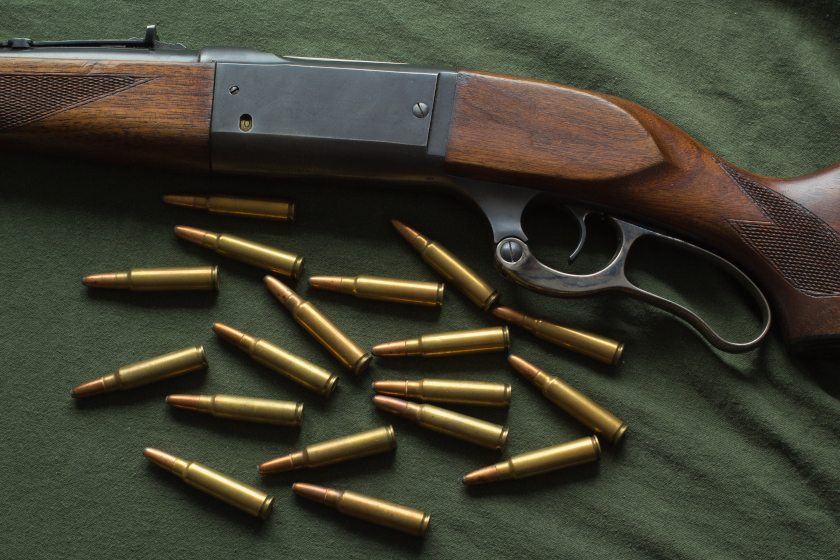
Getty Images: Kevin Brine
Talk about a lever-action rifle that was light years ahead of its time. As the name implies, the Model 99 was developed back in the late 1890s, ultimately being released for the first time in 1899. This gun, along with the Model 1895, introduced the world to the concept of a round feed rotary magazine. Prior lever-actions had utilized a tube feed magazine type.
This wasn't the first hammerless lever-action, but many will argue that it did perfect the concept. As the years passed, the gun was chambered in a plethora of unique chamberings including 22-250 Remington, .300 Savage, .30-30 Winchester, 7mm-08 Remington, .375 Winchester, and even .410 bore shotgun.
The Model 99 saw a little action in World War I in the hands of the Montreal Home Guard, but that's not what made the gun famous. The Savage found a place in the hearts of hunters everywhere in the decades that followed as one of the best deer guns to ever do it. Hunters everywhere relied on this rifle to fill their freezer season after season every year. To many a hunter's disappointment, the Model 99 was discontinued by Savage Arms in 1998. We've heard it was only because of rising production costs. It was allegedly an extremely labor-intensive rifle to build. We're going to hold out hope Savage decides to bring it back one day. We imagine a lot of hunters would be on board, even if it costs a lot more than the old school Model 99s.
Winchester Model 70
First introduced all the way back in 1936, the Winchester Model 70 proved its worth in both World War II and the Vietnam War. However, it was the gun's performance in the field on whitetails, mule deer, elk, and pronghorns that made it a legend. You'll often hear "pre-64" talked about when discussing these bolt guns. That simply refers to the fact that prior to 1964, the Model 70 used a Mauser-type controlled feed system. This just means the extractor grabs the rim of the brass to guide it into the chamber. The company changed the design slightly for many years before finally returning to that pre-'64 extractor again in more recent years. It's now the top selling point for this centerfire rifle.
The Model 70 also won a lot of points with hunters just for being a great looking gun. Those older models have some of the most beautiful hardwood stocks with exceptional checkering that gave the rifles excellent ergonomics. It also helps that the Model 70 has been chambered for a bevy of different cartridges over the years. Everything from the .223 Remington to the mighty .375 H&H Magnum, .458 Winchester Magnum, and even .470 Capstick has been available in the Model 70 platform.
Winchester still makes these rifles with a receiver forged from a solid block of steel, and the same three-position safety loved by hunters everywhere. Although these days they have introduced more variants to introduce more modern flairs to the gun like better recoil pads, the latest in synthetic stocks, and Cerakote finishes to keep hunters in the field longer.
Browning A5
Designed by the legendary John Browning in the early 1900s, this innovative firearm changed the game by being the first semi-automatic shotgun to be mass produced. Instantly recognizable for the trademark "humpback" receiver, this shotgun cycled rounds effortlessly through a recoil-operated system that even Browning himself heralded as his greatest achievement. That's saying something from a guy who designed firearms like the M2 Browning machine gun, the Browning Hi-Power handgun, and the Browning Automatic Rifle (BAR).
The A5 quickly found a following with both upland and waterfowl bird hunters who quickly discovered they were able to get follow-up shots on missed birds off faster than ever before thought possible. It's quite possible the A5 has killed more ducks than any other firearm out there today. The design was used by a few different manufacturers to produce variants like the Savage Model 720 and Remington Model 11. It was usually offered in 12, 20, and 16-gauge models.
This shotgun was discontinued for a while in 1998. That was until Browning brought the design back with a lot of modern features to bring the design fully into the 21st century. These days you can get an A5 with the latest in recoil pad technology and all the latest finishes and stock/forend variations. They offer 12 and 16 gauge models these days, but a lot of shooters are still pining for the company to re-release the 20-gauge models. We're sure Browning knows this, we're hoping it's just a matter of time before they bring them back.
Remington 700
For many years, the Remington 700 went head-to-head with the Winchester Model 70 in competition for America's favorite bolt-action rifle. Introduced in 1962, the main difference between this and the Winchester is the fact that Remington went with a push feed system rather than the controlled feed that made the Winchester so popular. In any case, the Remington enjoyed a better reputation with the military and is still in use today as a sniper rifle. Some of that reputation probably helped convince many hunters if it was good enough for our military, it would be perfect for the deer woods.
And the 700 delivered for hunters in other ways too. Remington engineer Mike Walker wisely realized the cost of production needed to be cut to make the gun more affordable without sacrificing on quality and accuracy. As a result, the 700 was a little more affordable than a Model 70, which is what ultimately drove Winchester to make those design changes away from the pre-'64 extractor we mentioned earlier.
Another wise choice by Remington was to market left-handed rifles at a time when few others were doing it. Add in the fact that the 700 was available in popular calibers like 7mm-08 Remington, .270 Winchester, .243 Winchester, .308 Winchester, .30-06 Springfield, and more, and you had an affordable rifle that appealed to the masses.
Marlin Model 336
The Winchester 1894 is often thought of as THE gun of the west, but the Marlin 336 is usually considered by most hunters to be the best deer hunting lever gun ever made. It's slightly heavier than the 94, but most shooters will tell you the Marlin is the better built and more accurate of the two rifles. A lot of that comes from the Marlin micro-groove rifling system, which was designed to cut production time, but also just proved to make the rifle a better shooter in the end. As we mentioned, the 336 is slightly heavier than the 94, but that also helps just a hair with accuracy and handling.
Barrel length on the 336 varied between 16 and 24 inches depending on the model. The shorter barrel lengths make it an ideal brush gun. Shooters really enjoyed how easy the model 336 was to clean, and how easy it was to attach a riflescope to the scope mounts. Most hunters who bought one of these rifles went for either .35 Remington or .30-30 Winchester. Although it has also been chambered for rounds like .444 Marlin, .45-70, .38 Special/.357 Magnum, and .44 Magnum/.45 Colt.
The Model 336 did stop production in 2020. This was while Remington was having financial woes and they ended up selling Marlin to Ruger. We have heard rumors that Ruger wants to restart production of the 336, perhaps with some more modern flairs on some new variants like picatinny rails and maybe some fiber optic sights. However, there hasn't been any news about them starting production just yet. We're guessing it's just a matter of time. Ruger would be leaving serious money on the table by not making more of this iconic rifle.
Weatherby Mark V
First developed in 1957, the Weatherby Mark V is still in production today and is known as being one of the better high end big game and deer rifles on the market today. Designer Roy Weatherby was a man who was known for extremely high powered big game cartridges and his penchant for safety. He wanted a hunting rifle that would not only be powerful but would also protect the shooter in multiple ways if failure were to occur. Especially since a lot of people who shared Weatherby's thoughts were making some seriously hot handloads at the time that could potentially rupture and injure the shooter.
Weatherby designed a nine-lug, push feed action system, an enclosed bolt face that cycled rounds exceedingly well. They also added holes to the bolt to re-direct hot gas away from the shooter's face in the event of a malfunction with ammo that had been handloaded. The result was the Mark V and it proved to be a huge hit.
These days the Mark V is a seriously impressive rifle. It features an extremely short 54-degree bolt throw for faster cycling and less worry about interfering with your scope, and the latest in carbon fiber stocks, barrels, muzzle brakes, and trigger technology. It also helps the Weatherby is available in literally dozens of different chamberings from the .240 Weatherby Magnum to popular rounds like .270 Weatherby Magnum, 7mm Weatherby Magnum, .243 Winchester, .25-06 Remington, .308 Winchester, .300 Winchester Magnum, .30-06 Springfield, and .270 Winchester. It's also available in large chamberings like .375 H&H Magnum, .416 Remington Magnum, .458 Winchester Magnum, and the mighty .460 Weatherby Magnum for when dealing with dangerous game like the Cape Buffalo in Africa.
Remington 870
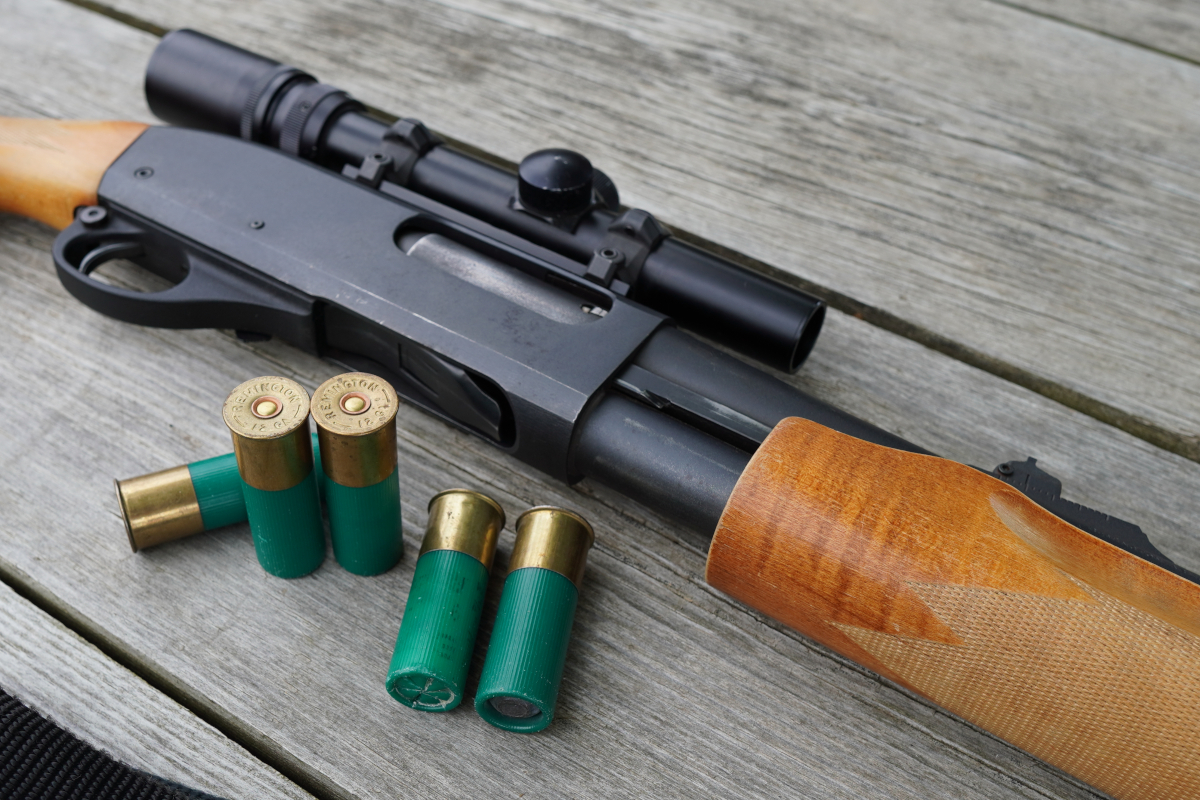
Travis Smola
This classic pump action shotgun has been in use by hunters since 1950 for good reason. It's affordable, versatile, and it's accurate. The designers at Remington went through several different iterations of pump gun prior to the 870. It was a man named John Pedersen who ultimately came up with the twin action bar system inside a solid steel receiver. There's really nothing at all fancy about the 870 with its bottom feed system into a tube magazine. And that's what made it cheaper to manufacture than some of the predecessors that came before it.
Add in the fact that when the 870 launched, it was available in 16, 20, and 12-gauge chamberings, and could handle both 2 ¾-inch shells and 3-inch magnums, AND it was affordable, well, Remington had an instant winner on their hands. Especially since the barrels could be swapped out. Put a vented barrel with a choke one day for hunting pheasants, ducks, and other birds, swap it out next month for a rifled barrel and use it to cheaply harvest a deer with a rifled shotgun slug.
In many ways, the Remington 870 changed the way hunters looked at shotguns. And for hunters on the budget, this gun was the best value on the market. They are still affordable today at $350-$400 for a brand-new one. There's a reason this is the best selling shotgun of all time.
Ruger 10/22
When it comes to popular rimfire rifles, the Ruger 10/22 is in a class by itself. Introduced by Ruger back in 1964, it was a few years after Marlin had introduced the Model 60, but we can argue the 10/22 had the bigger impact in the long run. If for no other reason than it was a serious semi-auto .22 long rifle designed for adults. This gun has an interesting tie to the Savage Model 99 from earlier in this list. Mainly because designer Bill Ruger was a huge fan of the 99's rotary magazine. This ultimately led to the 10/22 getting its iconic rotary mags as an integral part of the design. They also proved to be more reliable in feeding rimfire rounds than a box magazine.
An interesting piece from the American Rifleman also notes the early interest in the 10/22 probably also came from the aesthetics of the design. The original 10/22s looked a lot like the M1 Carbine which was used by the military from World War II through Vietnam. It's not much of a stretch to believe many buyers were former soldiers who were a bit nostalgic for their M1s they used in the service with the 10/22's looks.
Of course, the big thing that catapulted the 10/22 from simply being a great and accurate semi-auto rimfire for sportsmen and women was the number of variants and the accessories. Ruger sells no less than eight different types of 10/22 from a classic-looking carbine to the latest in competition, and even a couple of takedown models. And the accessories, there's an endless amount of them. You can change out everything from the barrel and stock to all the internal components if you so choose, making it possible to build the ultimate small game hunting gun.
For more outdoor content from Travis Smola, be sure to follow him on Twitter and check out his Geocaching and Outdoors with Travis YouTube channels.
NEXT: THE AXIS DEER AND HOW THEY'RE IMPACTING PARTS OF THE UNITED STATES
WATCH
